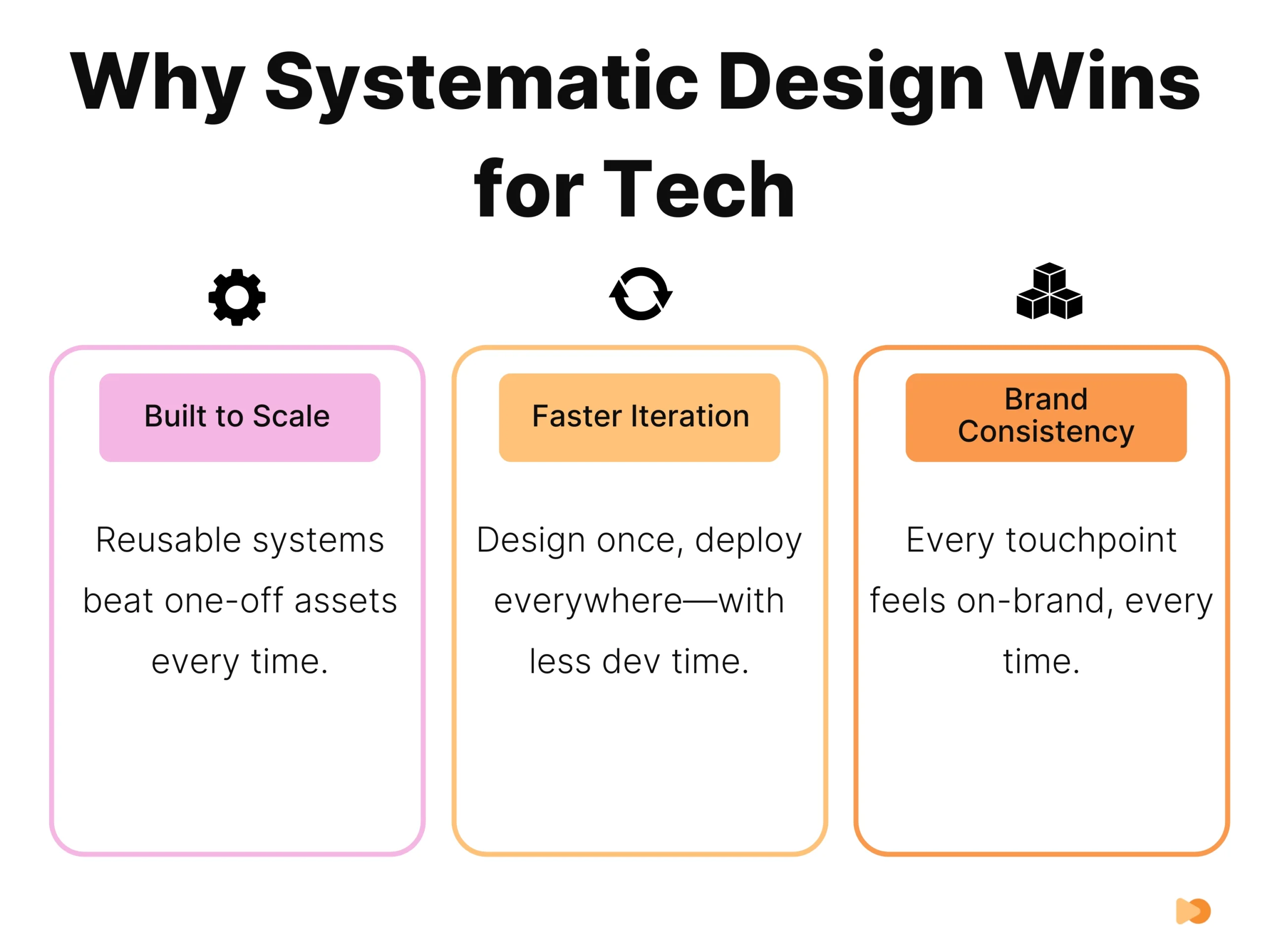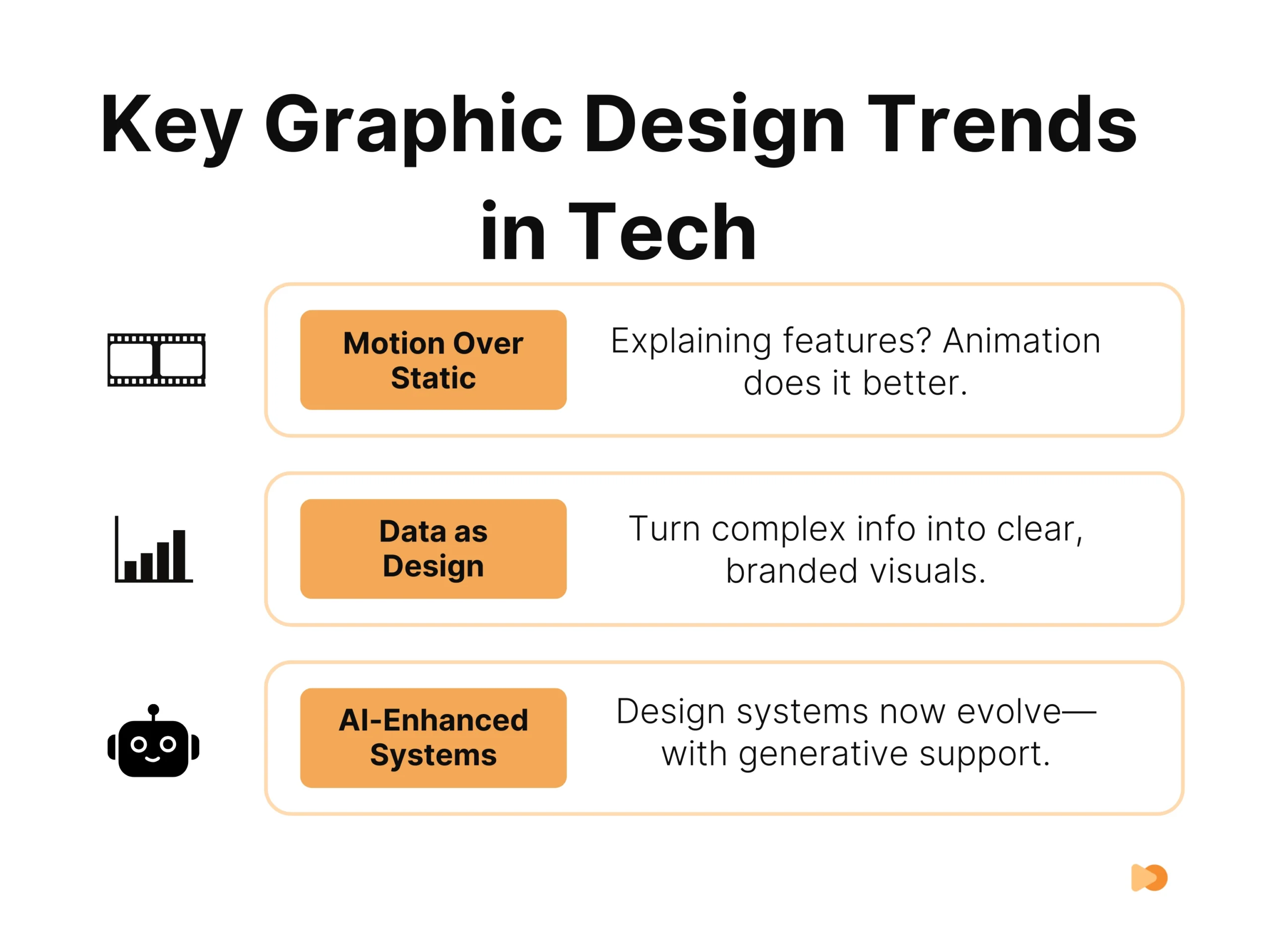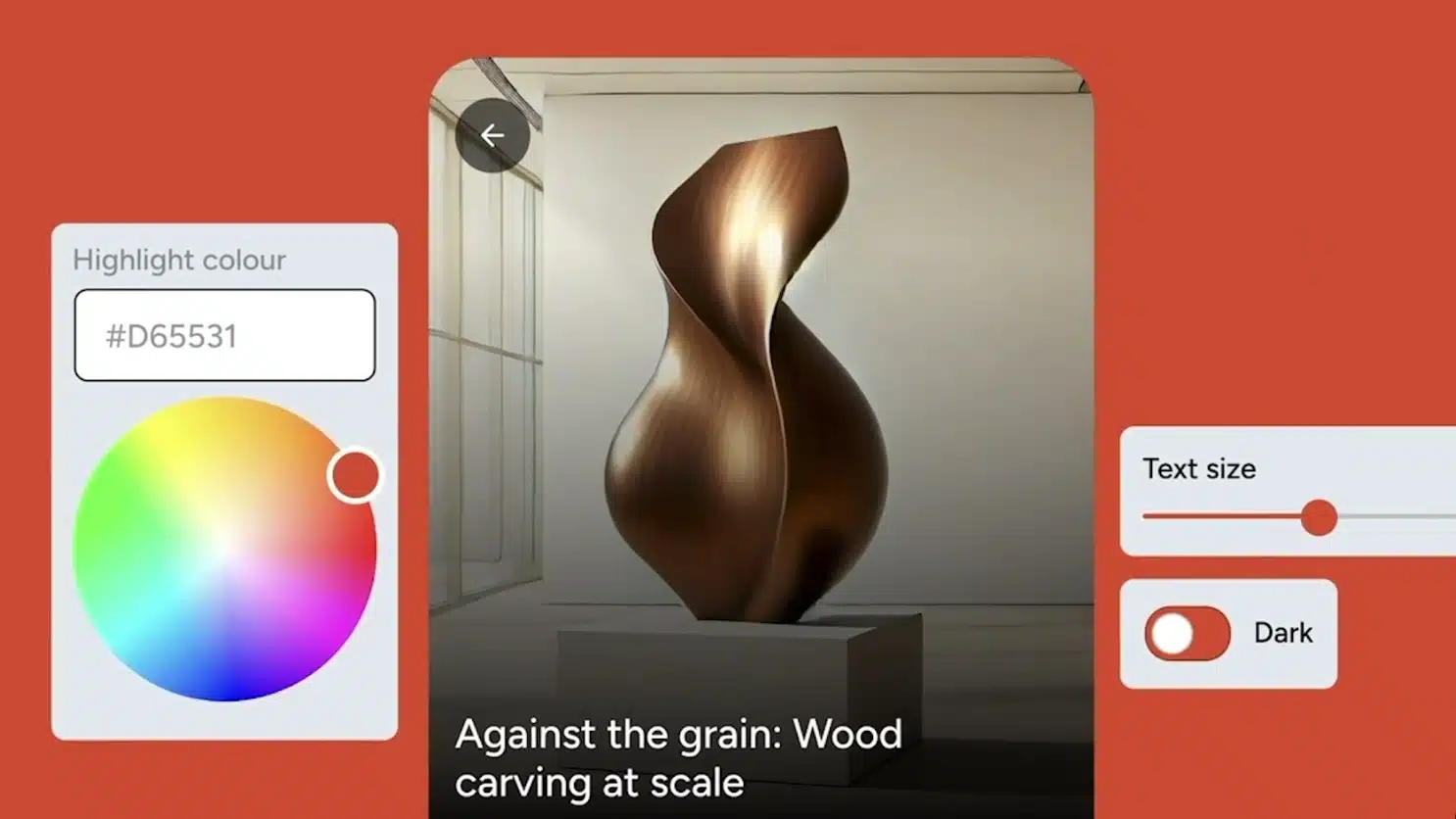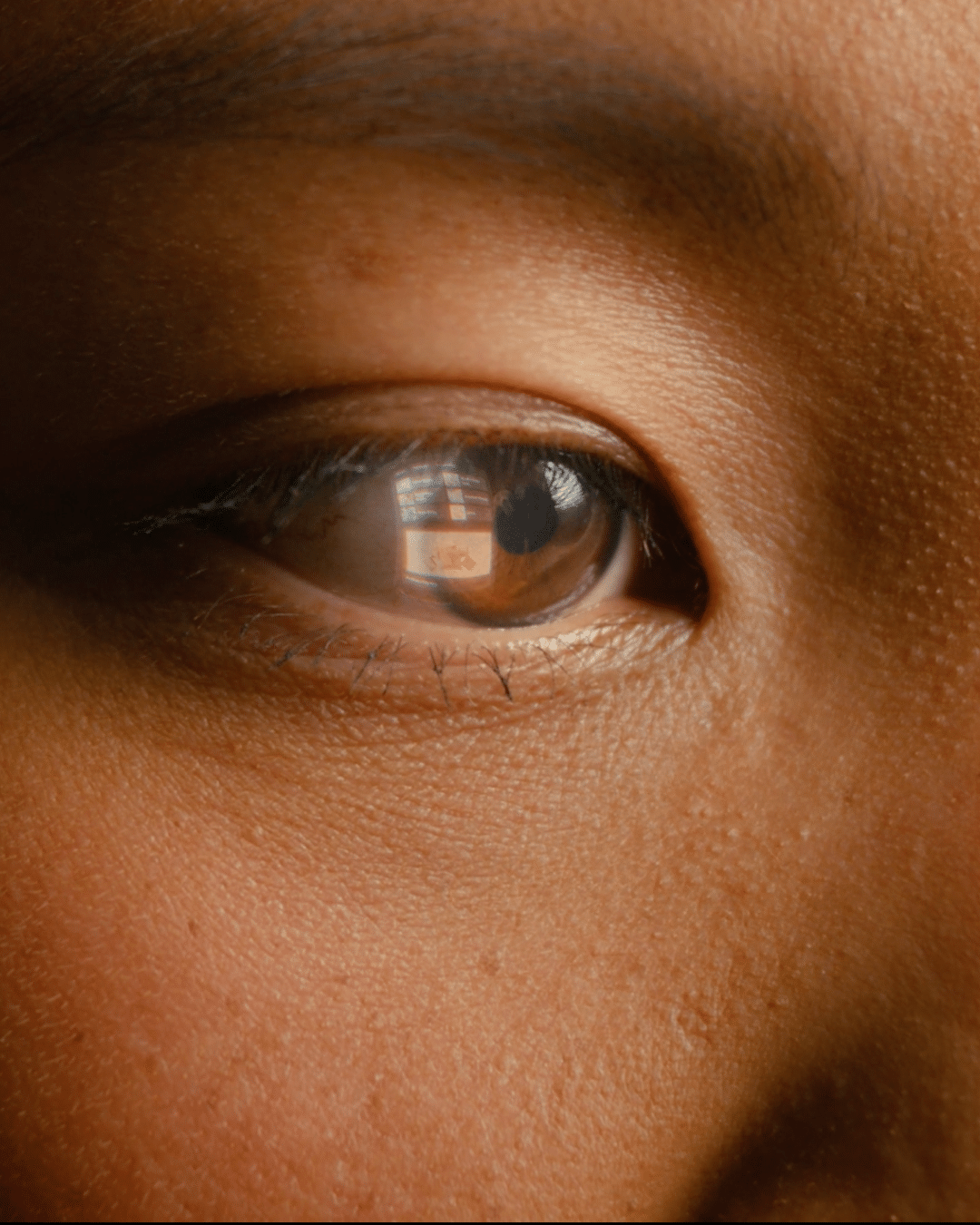Tech companies don’t just need design—they need design that performs.
From simplifying complex features to scaling visual identity across global channels, most teams struggle to maintain creative quality while moving fast. The result? Inconsistent assets, fragmented messaging, and visuals that look good, but don’t convert.
At Vidico, we’ve delivered over 1,200 creative projects for brands like TikTok, Square, and Spotify, helping them build scalable design systems that boost clarity, consistency, and business outcomes. Through that volume, we’ve identified which graphic design formats will actually move the needle and which ones will fall flat.
In this guide, we’ll break down the emerging types of graphic design that today’s tech marketers use to drive growth, and how you can apply them to your next campaign.
Content
Top 10 Essential Graphic Design Types for Tech
1. System-Based Brand Identity Design

Traditional brand identity focused on static guidelines. Today’s tech companies require dynamic, system-based approaches that maintain consistency while adapting to diverse applications. [1]
Why It Matters for Tech Companies: As tech brands rapidly expand across markets and product lines, traditional static brand guidelines often break down. System-based identity design creates flexible frameworks that maintain brand identity while enabling efficient scaling. Brand visual identity graphic designers who specialize in this approach are becoming essential members of any creative team.
Implementation Strategy: Rather than starting with rigid brand guidelines, we recommend beginning with a design system that defines core principles, components, and relationships. This creates a “design language” that can evolve and scale rather than a static set of rules that quickly become outdated as your tech company grows. Your graphic designers and art directors will thank you for this foundation.
Case Study: How Vidico Helped TikTok Scale Creative Production
Vidico partnered with TikTok to streamline their creative production process, resulting in impressive outcomes. By implementing a tailored design system, TikTok was able to produce high-quality content at scale, keeping up with their fast-moving teams.
“Vidico has been an incredible creative agency partner, and we couldn’t be happier with their work. From graphic design and video production to copywriting, they consistently deliver high-quality results—quickly, reliably, and at a fair price. They truly understand our business and always go the extra mile to ensure our partnership is both effective and enjoyable. – Jennah Blau, Global Head of Publisher Development, TikTok
Key Results:
- 10x increase in production speed
- 80+ designs delivered in just 2.5 months
- Over 40 creative video assets in multiple formats
- 40% increase in impression rate
2. Product Interface Design
As digital products become increasingly complex, the user interface layer between technology and users becomes critical to adoption and retention. UI graphic designers face unique challenges in balancing functionality with aesthetic appeal.
Why It Matters for Tech Companies: Product interfaces are often the primary way users experience your technology. Intuitive, visually appealing interfaces designed with strong graphic design principles can dramatically improve adoption, reduce support costs, and increase retention. The graphic design industry has evolved significantly to address these specific UI design challenges.
Implementation Strategy: We suggest focusing on creating systematic UI components rather than one-off interface designs. Establish a design system with reusable elements that solve specific interaction challenges while maintaining visual hierarchy and consistency. This enables your product team to rapidly iterate without starting from scratch each time, a valuable skill for any UI designer to develop.
Watch What You Need from a Creative Agency in 2025 to see how today’s top art directors and creative directors are approaching design systems.
3. Motion Graphics Design
Static visuals struggle to explain complex tech concepts. Motion graphics design has emerged as an essential tool for illustrating functionality, data flows, and user journeys. Motion graphics designers now play a critical role in tech marketing strategies.
Why It Matters for Tech Companies: Motion graphics helps bridge the gap between complex technology and user understanding. For tech companies, motion is no longer decorative—it’s a functional necessity for explaining how products work and guiding user behavior. Creating visual content that moves effectively requires specialized graphic design skills.
Implementation Strategy: We recommend establishing motion principles that define how your brand moves. Create a library of standard animations for common interactions and transitions, including animated logos if appropriate. This allows your creative team to create consistent motion across products without reinventing the wheel each time—a technique used by leading motion graphics designers worldwide.
Case Study: DigitalOcean App Platform Explainer Video
Vidico collaborated with DigitalOcean to create an explainer video for their new App Platform, aiming to effectively communicate its features to developers.
“The ROI we were getting, the cost per acquisition and the ARPU just for the views have really been effective. The cost has been low per customer when they’re transitioning from our youtube to our website and purchasing our platform via that video. + Over 3.7 million views on Youtube. + Lowered CPA.” – Adam Harder, Senior Video Operations Manager, DigitalOcean
Results:
- 3.7 million views on YouTube
- 70% average view rate for a 2-minute video
- Low cost per acquisition (CPA) via YouTube ads
- Positive viewer engagement, with many choosing not to skip the ad
The video was widely distributed across various platforms, including DigitalOcean’s website, YouTube, and social media channels. The campaign demonstrated a high return on investment (ROI), with the video continuing to perform well months after its release.
For more details, you can view the full case study here: Vidico x DigitalOcean App Platform.
4. Data Visualization Design
As data becomes increasingly central to tech products, the ability to transform complex information into intuitive visuals has become a critical design discipline. Graphic designers specializing in this field combine analytical thinking with visual communication expertise.
Why It Matters for Tech Companies: Data visualization bridges the gap between complex information and user comprehension. For tech companies dealing with massive datasets, effective visual elements can be the difference between providing value and overwhelming users. Many designers are now focusing specifically on this growing niche.
Implementation Strategy: We suggest developing a consistent visual system for representing data that aligns with your visual identity while prioritizing clarity and comprehension. Create designs, templates and components for common data visualization needs to ensure consistency and efficiency. Your UI designers and graphic designers should collaborate closely on these graphic elements to maintain visual hierarchy throughout.
Subscribe to the Video for Growth Newsletter for weekly tips and insights.
5. Microsites & Landing Page Systems
The proliferation of campaigns, product launches, and feature announcements has created demand for rapid deployment of focused web experiences. Web designers need to balance creativity with systematic approaches to maintain efficiency.
Why It Matters for Tech Companies: As product offerings expand and marketing campaigns multiply, tech companies need to create dedicated digital destinations without starting from scratch each time or fragmenting their brand experience. Web design has become a critical component of the broader graphic design industry.
Implementation Strategy: We recommend creating a flexible system of page templates and components that can be rapidly configured for different needs. Focus on establishing patterns for common elements like headers, hero sections, feature highlights, and social media ads. This enables your creative team to quickly deploy new pages without sacrificing quality or consistency.
Learn from our Design System Concept to better understand how to create cohesive frameworks that web designers and UI designers can scale efficiently.
6. Packaging Design Systems
As tech companies expand into physical products, systematic approaches to packaging design have become essential for maintaining brand consistency while adapting to diverse product needs. Packaging designers now play a crucial role for many tech brands.
Why It Matters for Tech Companies: Physical packaging often provides the first tangible interaction with your brand. Systematic packaging designers ensure consistent brand expression across product lines while enabling efficient adaptation to new offerings. For many designers, this represents an exciting blend of digital design principles with traditional printed materials expertise.
Implementation Strategy: We suggest establishing a packaging design system that defines structural patterns, material specifications, and visual applications. Create templates for different packaging types that maintain consistent key elements while allowing for product-specific adaptation. This approach will help your packaging designers maintain efficiency without sacrificing creativity.
7. Environmental Graphic Design Systems

As tech companies invest in physical spaces—from offices to retail environments—systematic approaches to environmental graphic design have become essential for creating consistent spatial experiences. Environmental graphic designers work at the intersection of digital and physical brand touchpoints.
Why It Matters for Tech Companies: Physical spaces represent important brand touchpoints that should align with digital experiences. Systematic environmental graphic design ensures consistent brand expression across locations while enabling efficient adaptation to diverse spaces. Environmental graphic designers are increasingly valuable to tech brands with physical presence.
Implementation Strategy: We recommend establishing an environmental design system that defines spatial applications of your brand elements, material specifications, and implementation guidelines. Create a toolkit of environmental graphics components that maintain consistent brand expression while adapting to different spaces.
8. Publication Design Systems
Despite the digital shift, publication design remains important for tech companies creating whitepapers, reports, case studies, and other long-form content. Publication designers are applying systematic approaches to maintain brand consistency across these materials.
Why It Matters for Tech Companies: Long-form content provides important opportunities for in-depth storytelling and thought leadership. Systematic publication design ensures consistent brand expression across diverse content while enabling efficient production of new materials. Many designers from print and publication industries are now specializing in digital publication formats.
Implementation Strategy: We suggest establishing a publication design system that defines layout grids, typography patterns, and visual element applications. Create templates for different publication types that maintain consistent design principles while allowing for content-specific adaptation.
Use our Creative Brief Template to streamline your next design project. Comment for access to this valuable tool for your creative team.
9. Illustration Design Systems
As tech companies seek to humanize complex concepts, systematic approaches to illustration have become essential for maintaining consistent visual storytelling across products and marketing. Graphic illustrators now play a crucial role in tech brand communication.
Why It Matters for Tech Companies: Illustrations help explain abstract concepts and create emotional connections with users. Systematic illustration design ensures consistent visual storytelling across touchpoints while enabling efficient creation of new assets. Creating illustrations that balance creativity with systematic consistency has become a specialized skill in the graphic design industry.
Implementation Strategy: We recommend establishing an illustration design system that defines character styles, object representations, and compositional approaches. Create a library of illustration components that can be assembled for different scenarios while maintaining consistent visual language.
Also read: Best Illustration Agencies & Services
10. Advertising Design Systems
The proliferation of marketing channels has created demand for systematic approaches to advertising design that maintain consistency while adapting to diverse formats and platforms. Advertising designers now need to think systematically across all touchpoints.
Why It Matters for Tech Companies: Consistent advertising design across channels strengthens brand recognition and campaign impact. Systematic approaches ensure visual cohesion while enabling efficient adaptation to diverse formats—from print ads to digital marketing assets including social media ads.
Implementation Strategy: We suggest establishing an advertising design system that defines campaign architecture, format specifications, and visual application guidelines. Create templates for different advertising formats that maintain consistent brand elements while adapting to channel-specific requirements.

How to Implement Systematic Design at Your Tech Company
Creating systematic approaches to these design disciplines requires a strategic shift from project-based thinking to design systems development. Here’s how to start:
- Audit Your Current Approach: Identify where your creative team is creating one-off designs versus systematic frameworks. Look for opportunities to establish visual hierarchy and design principles across your creative output.
- Prioritize High-Volume Needs: Focus first on areas where you’re producing the most visual assets or experiencing the most consistency challenges. This is where graphic design principles can make the biggest immediate impact.
- Start With Core Components: Begin building modular systems by defining your most frequently used design elements. These key elements will form the foundation of your design system.
- Establish Design Principles: Create clear guidelines that inform how your system should evolve and adapt to new needs. These principles will guide both your internal graphic designers and other designers you might work with.
- Implement Asset Management: Develop processes for organizing, accessing, and maintaining your design system components using appropriate digital tools. This infrastructure supports your entire creative team.
Schedule a meeting to discuss project scope, timelines, or budgets.

FAQs
What is the most popular type of graphic design?
Branding and marketing design, including logos, advertisements, and social media graphics.
Is Canva graphic design?
Yes, Canva is a graphic design tool that allows users to create various types of designs easily. [2]
Is a logo a graphic design?
Yes, a logo is a form of graphic design that visually represents a brand or company.
What is the easiest graphic design?
Simple social media graphics or basic poster designs are often considered easier.
How does a systematic approach to graphic design benefit tech companies specifically?
Systematic design approaches enable consistent brand expression across expanding touchpoints, efficient scaling of design resources to match growth, and frameworks for explaining complex functionality clearly. For tech companies, design systems aren’t just about aesthetics—they’re operational necessities for maintaining quality while scaling. Great graphic designers understand this distinction and design accordingly.
What’s the difference between traditional graphic design and system-based design?
Traditional graphic design focuses on creating finished assets for specific needs (a logo, a brochure, a website). System-based design instead creates frameworks, components, and rules that enable efficient production of multiple assets while maintaining consistency.
How can our marketing team start implementing more systematic design approaches?
Start with your highest-volume design needs where inconsistencies are most visible or costly. Begin by documenting existing design elements, establishing core principles, and creating simple component libraries that your marketing designers can leverage. Focus on building a career path for your design team that values systematic thinking alongside creative skills. Even small businesses can benefit from this approach to graphic design by starting with simple systems that grow over time.
Key Takeaways
As tech companies navigate increasingly complex visual communication challenges, systematic approaches to graphic design have become essential for maintaining quality while scaling efficiently. By building modular, reusable design frameworks rather than creating one-off assets, tech brands can achieve consistent expression across touchpoints while dramatically improving production efficiency.
At Vidico, we’ve helped leading tech companies implement these approaches across their visual communication needs, from brand identity to user interface to marketing materials. The result is not just better design, but better business outcomes: faster time to market, more consistent brand experiences, and more efficient use of creative resources.
Book a free strategy session and get expert guidance on implementing systematic design approaches for your tech company’s marketing strategies.
References:
- https://www.investopedia.com/terms/b/brand-identity.asp
- https://www.businessinsider.com/guides/tech/what-is-canva






